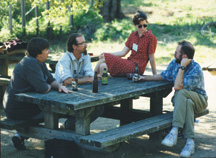 Participants
at the Tenth Annual IRIS Workshop. (Photo: M. Hasting)
Participants
at the Tenth Annual IRIS Workshop. (Photo: M. Hasting) Participants
at the Tenth Annual IRIS Workshop. (Photo: M. Hasting)
Participants
at the Tenth Annual IRIS Workshop. (Photo: M. Hasting)
Over 230 seismologists recently wandered among the redwoods of the University of California, Santa Cruz campus to attend the 1998 IRIS workshop. This year's workshop was the first to be held on a college campus, as guests doubled up in student apartments and enjoyed cafeteria food with unlimited free ice cream. Talks began early on Thursday, July 9, focusing on the San Andreas Fault (SAF) as an example of a continental transform boundary. Rick Sibson compared the SAF to the Alpine fault in New Zealand. Tanya Atwater presented a computer animated history of the North American-Pacific plate boundary and described the constraints on relative plate motion. Paul Segall and Ken Hudnut described strain measurements and inversion methods in northern and southern California, respectively. Tim Henstock discussed crustal structure near continental strike-slip boundaries; while Kevin Furlong related strain localization to plate boundary evolution. In the final afternoon talk, Ross Stein reviewed recent progress in understanding how the stress changes caused by earthquakes can trigger future earthquakes.
Late Thursday afternoon, the W. M. Keck Seismology Laboratory hosted a reception in their new building. Following dinner, Tom Jordan described the status of the National Research Council's Science of Earthquakes report.
Friday morning focused on applications of high-resolution seismic imaging for shallow structures. Following an introduction by Anne Meltzer, archeologist Payson Sheets described geophysical exploration at the Ceren site in El Salvador; climate modeler Tom Johnson presented records of climate changes recorded by African lakes; Dave Roelant described government programs for environmental monitoring; and Roelof Versteeg presented time varying images of shallow structures. Field trips that afternoon included hiking, sailing on Monterey Bay, and sampling products of nearby wineries.
Saturday morning talks reviewed the heat flow paradox, and how faults can slip at low apparent levels of shear stress. Wayne Thatcher began by describing how ductile shearing below the brittle crust should generate heat flow anomalies. Next Mike Blanpied reviewed laboratory results for rock friction; and Peter Mora described numerical simulations of faulting. Finally, Greg Beroza reviewed constraints on rupture provided by seismic observations.
Talks on Saturday afternoon covered the future of regional seismic networks and outlined possible major new initiatives in seismology. Ian MacGregor presented the National Science Foundation's perspective on long-range planning in the Geosciences. Harley Benz and Steve Malone described research results and coordination among the regional seismic networks. Ralph Stephen reported encouraging results from the Ocean Seismic Network Pilot Experiment. Paul Silver presented the case for the proposed Plate Boundary Observatory (see article on page 3). Gene Humphreys and Göran Ekström described the types of instruments and experiments proposed for the USARRAY concept (see article on page 2).
Poster sessions were held throughout the workshop and provided a focus for informal discussions. The workshop concluded with a barbecue dinner on Saturday evening.
 Harold
Bolton, Keith Richards-Dinger, Megan Flanagan, and Peter Shearer at the IRIS
Workshop. (photo: M. Hasting)
Harold
Bolton, Keith Richards-Dinger, Megan Flanagan, and Peter Shearer at the IRIS
Workshop. (photo: M. Hasting)
Return to: IRIS Newsletter
Information
Return to: Title Page and Table of Contents
Continue to: Next Article